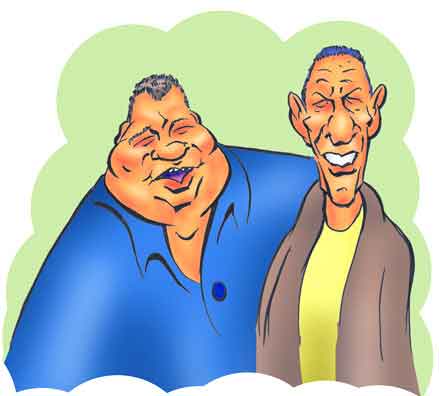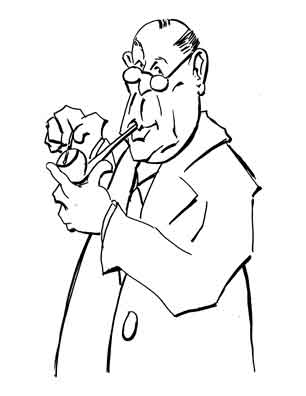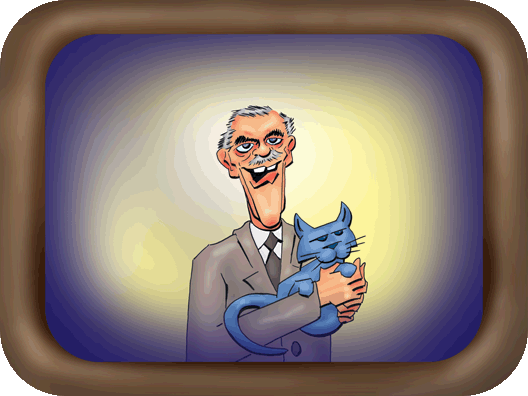William Shatner and Leonard Nimoy
Most Unique

William Shatner and Leonard Nimoy
Quite Different
As you can tell from this drawing, William Shatner and Leonard Nimoy are as much the diametric opposites as were their fictional counterpart. We mean, of course, Captain James Tiberius Kirk and his first officer Commander Spock.
And no, we don't mean it was because Spock was coldly logical and always deliberate in his actions while Kirk was emotional and at times over-hasty when making decisions (as depicted in the Star Trek episode, "Arena", certainly one of the most unintentionally hilarious of the original shows).
Nor is it because Kirk actually used profanity (on "The City on the Edge of Forever") while Spock never used coarse expressions.
And it isn't because Kirk would sometimes hit the bottle while Spock never drank alcohol (well, as we see on "The Enterprise Incident", hardly ever").
No, the big difference is that although Leonard is relatively easy to caricature, Bill (as his friends call him) is probably the greatest challenge for any humorous artist. Even the great Mort Drucker in his Mad Magazine parodies "Star Blecch" and "Keep on Trekin'" had trouble drawing Bill.
The ability to defy caricaturial representation is usually due to the likeness not being defined by a few distinct features. Instead the problems arise when recognizability is from slight departures from the norm in a number of facial characteristics.
It's not always obvious who makes a difficult subject. For instance, you would expect that with his rotund figure, jowly visage, and smooth pate, the writer Clive Staples "Jack" Lewis would be easy to draw.
While not denying that Jack was rotund, jowly, and had a smooth pate, what makes Jack look like Jack is really that collection of small and subtle features that must fit together correctly to have Jack. It is really a surprise how few of the caricatures of Jack actually look like him. But it's also a sad truth that when the pressure of deadlines prevail sometimes you just have to live with the less than perfect caricature.

Jack Lewis
A Challenge to Artists
As to which feature is the most important when trying to achieve a likeness, you get different answers depending on who you ask. One modern and expert portraitist said it is the eyes. But Gilbert Stuart - America's premiere colonial portrait painter - said it was the nose as many beginning portraitists assume. Thomas Sully, on the other hand and while saying he did not want to disagree too strongly with a master like Mr. Stuart, believed the crucial feature was the mouth.
You can, if you wish, turn the question over to the modern cognitive scientists. They - not surprisingly - give you as varying answers as do portrait painters. Some say the order of importance is 1) eyes, 2) mouth, and 3) nose. Others rank nose above mouth. Some have even said the most important feature is the brows, for crying out loud!
A Humble CooperToons Opinion is ranking of features for facial recognition varies with the individual. I mean, if you've got a big schnoz, that's what people will see. If you have doe-eyes, that's what people first notice. And a massive protruding malocclusion will always draw attention. But when none of the features predominate, that's when caricaturists have trouble.
However, as Bill aged he became a bit more caricature friendly. That, though, is true for virtually anyone. Smooth Adonis or Daphne features are difficult to exaggerate. But craggy and flabby faces offer much more for the artist.
Both Leonard and Bill had what you can call careers typical for iconic actors. They had some years of guest appearances on various television shows before landing their starring roles that made their names. Then after the inevitable career slump, they bounced back.
But saying Bill was typecast isn't really quite true. After Star Trek he had other series before his famous and successful role in Boston Legal. One reasonably successful early post-Star Trek series was T. J. Hooker. This was a police show, and on one episode Leonard was a guest star and played a good cop who went bad.
Another series - often forgotten - was Barbary Coast. This was a western that was sort of a combined elements of The Wild Wild West and Have Gun, Will Travel. Bill played Jeff Cable, who was a government investigator sort of like James West. And Jeff operated out of a saloon on what was called the Barbary Coast in San Francisco. The set-up was similar to the way Paladin's home base was the Carlton Hotel. On one show Jeff thought he had captured John Wilkes Booth when all he really had done was nab someone who looked like him. Mercifully the show lasted only one season.
For his part, Leonard took over Martin Landau's spot on Mission Impossible for two seasons. His performance was quite creditable, and in 1973 and 1974, Bill, Leonard, and the other cast regulars lent their voices to Star Trek: The Animated Series.
Bill and Leonard were fledgling actors when the anthology series was popular. A television anthology was a show where each episode presented an entirely new story with different actors. Although the genre has not vanished, anthologies were much more common during the 1950's and 60's and provided roles for then little known but capable actors.
Bill did quite a few anthology shows such as Playhouse 90, Kraft Theater 90, Alfred Hitchcock Presents, Thriller, The Dick Powell Theater, and of course, The Twilight Zone. He also appeared in movies including Judgment at Nuremberg and The Outrage, the latter starring Paul Newman and Claire Bloom. Bill plays a young Spanish priest.
One of Bill's most famous early television shows was Nightmare at 20,000 Feet on The Twilight Zone. Another notable appearance was on Thriller hosted by Boris Karloff. One of the episodes, The Grim Reaper (co-starring with Natalie "Mrs. Howell" Schafer), has Bill uncharacteristically playing a money-grubbing murderer who - of course - gets his just desserts.

Boris Karloff's Thriller:
Bill got his just desserts.
Naturally Bill and Leonard had their stints as guest spots on regular series as well. Leonard in particular can be seen on many of the old favorites such as Seahunt, The Untouchables, Gunsmoke, Wagon Train, and even Get Smart.
All true fans of Hollywood trivia know the first tandem appearance of Leonard Nimoy and William Shatner together was in "The Project Strigas Affair" on The Man from UNCLE. It's actually one of the better shows but readers are surprised when they read that Bill said he didn't remember meeting Leonard. How, you ask, was that possible if they were in the same show?
Well, when making the "The Project Strigas Affair" Bill and Leonard probably didn't see each other that much. They are only in two scenes together, and the way the shows were shot the actors would not need be around unless they were shooting scenes in which they appeared. Bill once pointed out that when filming Star Trek, he would see supporting cast members like George Takei and Walter Koenig only a couple of days a week. So it's not unusual that Bill wouldn't remember Leonard, who was, like him, just another guest actor.
Another bit of esoterica is that the bad guy was Werner Klemperer. Yes, Colonel Klink. Werner plays a war-mongering and conniving diplomat and he does so quite convincingly. Werner could certainly do much more than just say "Aaaaaahhhhhhh, Colonel Hogan!"
One of Bill's notable but lesser known appearances - to his American fans - was in 2012 when he was guest host on Have I Got News for You?, the popular British comedy/panel show. He received thunderous applause when he entered through a sliding Star Trek-like automatic door.
The show - usually abbreviated as HIGNFY - has been one of the most popular and longest running programs on the BBC but is virtually unknown to Americans. Despite the considerable fame in the UK of the two team captains, Ian Hislop and Paul Merton, Bill apparently had known of neither (and he's Canadian!). At one point he referred to Ian as "Ian Hilsop" and Paul as "Paul Morton". Bill also stumbled over the name of Chelsea footballer, Didier Drogba ("Why doesn't he change his name?" he asked). In a later interview, Bill mentioned the show but couldn't remember its name.
The big debate is why the original Star Trek was cancelled after three paltry seasons. Actually, that wasn't too bad a run for the time. It's true popularity remains a bit uncertain. You will read that ratings were often hitting #1 or #2 for the time slot. That sounds pretty good until you realize there were only three networks.
In any case, for the third season NBC switched the show to Friday night at 10 pm. Such a time is the harbinger for cancellation. Teens would be out with their friends and the younger kids would be in bed. So the show was canceled due to the poor ratings from a bad third season schedule.
But this answer just begs the question. Why the time-slot switch?
Alas, Star Trek wasn't the only show on the air. There were even bigger (although now forgotten) stars and (ostensibly) more popular shows vying for primetime. So in the end it was competitive pressure and contractual stipulations that shunted Star Trek to the "death slot".
Not that the producers didn't try to compensate for the loss of a younger audience, and the writing began to target an adult market. But science fiction without young fans is a contradiction, and while some of the latter shows were among the best, others were pretty pud. So the ratings did drop and the show was cancelled in 1969.
Fortunately, there were enough episodes in the can (nearly 80) to allow the show to go into syndication almost immediately. By that time, many of the kids who had watched the show at home began heading off to college. Soon it became de rigueur for the denizens of the dorms to plop down in the lounge after classes and see what was happening on Star Date 4523.3. And with the show being in syndication you might catch the doings on the Starship Enterprise every day.
Hence came the Trekkies. The first true Star Trek convention was held in 1972 in New York City. Although small scale by later get-togethers, it quickly led to the extravaganzas with the appearances of the cast members and other famous guest speakers.
Still, Star Trek remained something most suitable for nostalgia nerds. Then came 1979 and Star Trek: The Motion Picture. Although a disappointment to many fans - it was almost an unintentional parody of the show - the next movie - The Wrath of Khan - was a real Star Trek adventure (and was actually a continuation of one of the original shows). Alas, Spock was killed but at the end you knew he was coming back.
References
"Inside Star Trek: The Real Story", Herbert Solow, Robert Justman, Pocket Books, 1996. In addition to giving a good look into the making of the series, there are some rather pointed comments of what happens when MBA's with absolutely no experience in television or film making try to run the show. For one thing they would use stock business buzz phrases without a clue if it meant anything and tell a director to "itemize the following years goals and objectives as to improving productivity in the interactions with your customers."
"Star Blecch", Mort Drucker (Artist) and Dick De Bartolo (Writer), Mad Magazine, December 1967, pp. 4-8.
"Keep on Trekkin'", Mort Drucker (Artist) and Frank Jacobs (Writer), Mad Magazine, October 1976, pp. 4-10.
The Mad Art of Caricature, Tom Richmond, Deadline Demon Publishing, 2011.
"William Shatner", Internet Movie Data Base.
"Leonard Nimoy", Internet Movie Data Base.
"Star Trek: The Real Reason Why NBC Cancelled The Original Series Revealed?", Brian Chapman, What Culture, November 19, 2013
"The Truth About What Went Wrong With The Third Season Of Star Trek", Charlie Jane Anders, IO9, February 5, 2015.